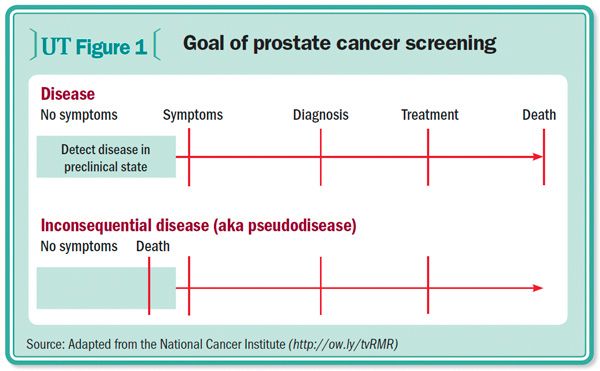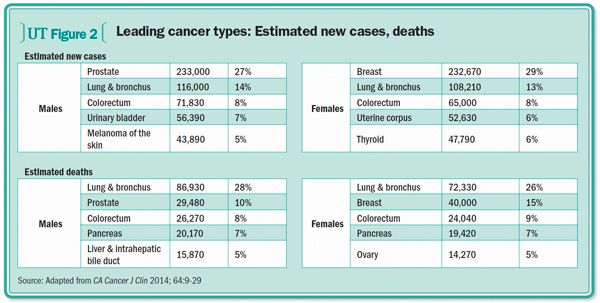Article
How to talk to patients about prostate cancer screening
In this article, I outline my patient discussion concerning prostate cancer screening, which includes defining what the PSA test is, why to screen or not to screen, the screening controversy, current guidelines, and decision aids.

John M. Hollingsworth, MD, MS

Series Editor Christopher M. Gonzalez, MD, MBA
Dr. Hollingsworth is assistant professor of urology, University of Michigan Medical School, Ann Arbor. Dr. Gonzalez is professor of urology at Northwestern University's Feinberg School of Medicine, Chicago.
Not a clinic of mine goes by without at least one man, typically in his late 50s or early 60s, bringing in a recent newspaper clipping or magazine article on the “harms” of prostate-specific antigen (PSA) screening for prostate cancer. Although PSA screening has been the subject of controversy in primary care for a number of years, discourse about it in the lay press heightened following recommendations from the American Academy of Family Physicians (AAFP) and the United States Preventive Services Task Force (USPSTF) against its use in asymptomatic men regardless of age.1,2 After listening to the patient’s concerns, I tell him that my goal is to keep him healthy with care that is right for his needs, which may or may not involve PSA screening.
In this article, I further outline my patient discussion concerning prostate cancer screening, which includes defining what the PSA test is, why to screen or not to screen, the screening controversy, current guidelines, and decision aids.
What is the PSA test?
Many men have confusion about what PSA screening entails. To begin, I clarify that PSA is a protein produced by cells in the prostate gland, which has a role in reproduction. I explain that the PSA test is used to measure the level of PSA in the blood. The results (reported in nanograms of PSA per milliliter of blood) are known to be age dependent. Elevations can be seen with a number of benign conditions, including benign prostatic hyperplasia, prostatitis, and urinary tract infection. However, the blood level of PSA may also be high in men with prostate cancer.
While initially used to monitor for disease progression among men with known prostate cancer, the PSA test (when combined with findings from digital rectal examination) was approved by the FDA in the 1990s to screen for prostate cancer. It is important to differentiate between use of the PSA test for diagnostic and screening purposes. Diagnostic testing applies to men with lower urinary tract symptoms or other signs of underlying pathology, whereas screening applies to the use of the PSA test in asymptomatic men, the intent of which is to find prostate cancer early (in the preclinical phase) when it is usually easier to treat (figure 1).
Next: To screen or not to screen

More "Hands On" articles
Oncofertility: Current practice and vision for the future
How to manage testicular/groin pain: Medical and surgical ladder
How to prevent stone formation in patients with metabolic syndrome
To screen or not to screen
Next, I review with patients the considerations that surround screening for any disease, of which there are four:
• First, the burden of the disease must be substantial. As the most common non-cutaneous malignancy among men causing nearly 30,000 deaths annually (figure 2),3 few would dispute the public health burden of prostate cancer.
• Second, the test used to screen must be sensitive for the disease at the preclinical phase. Although there is no absolute cutpoint of PSA with simultaneous high sensitivity and high specificity when monitoring healthy men for prostate cancer, prospective studies have shown good receiver operating characteristics for the PSA test, particularly in men younger than 70 years.4
• Third, there must be an intervention available to treat the disease during the preclinical phase that leads to reduction in both disease-specific and overall mortality. Indeed, high-quality data from the Scandinavian Prostate Cancer Group show that-with 15 years of follow-up-prostate cancer-specific and overall mortality were 38% and 25% lower, respectively, among men who underwent radical prostatectomy, when compared to those managed with watchful waiting.5
• Finally, the adverse effects of screening and downstream treatment should not be considerable. While prostate biopsy and prostate cancer treatments carry measurable risk,6 a better understanding of pelvic anatomy and technological advancements have increased the palatability of both.
Next: Addressing the controversy
Addressing the controversy
As mentioned above, most concerns that men have about PSA screening stem from the AAFP and USPSTF recommendations against it. When addressing the controversy, I acknowledge to patients that the PSA test is imperfect. PSA screening is often used indiscriminately. Empirical work demonstrates high rates of use in populations that stand to benefit little from early detection.7 What’s more, PSA screening can be inconclusive. Consequently, some men may undergo repeated blood draws and unnecessary prostate biopsy. Further, PSA screening may lead to the detection and treatment of indolent cancers that were never destined to cause death.8
Having made these statements, abandoning PSA screening is akin to throwing the baby out with the bath water. The USPSTF recommendations were heavily influenced by findings from the Prostate, Lung, Colorectal, and Ovarian (PLCO) Cancer Screening Trial, which showed no mortality benefits from PSA screening.9 However, the PLCO trial had multiple flaws, including a high contamination rate of the controls (PSA testing approached 52% in the study’s usual care group). The USPSTF gave little weight to the European Randomized Study of Screening for Prostate Cancer or the Göteborg population-based screening trial, both of which showed a small but significant survival benefit associated with PSA screening for men under age 70.10,11

Current guidelines
Despite the AAFP and USPSTF recommendations against PSA screening, I point out to patients that other organizations, like the American College of Physicians (ACP), American Cancer Society (ACS), and American Urological Association (AUA), take a different stance on it.12, 13, 14 All three organizations recommend that patients and doctors discuss the potential benefits and harms of screening before a PSA test is done. Neither the ACP nor the AUA recommend routine PSA screening in men age 70 years and older. For men with a clear preference for screening, the ACP recommends that only those between 50 and 69 years of age should have the PSA test. For men at average risk, the AUA is more restrictive, indicating that only those between 55 and 69 should be considered for screening. Consistent with the ACS, the AUA also does not recommend screening among men with a life expectancy of less than 10 years.
Decision aids
Common to the guidelines from all three organizations is an emphasis on shared decision making between the patient and physician. To assist with this process, several decision-support technologies (or decision aids) have been developed, including one from the American Cancer Society that is well done (seehttp://ow.ly/tvSbv). Decision aids are interventions designed to help patients make specific and deliberate choices among options by providing information on the options and outcomes relevant to a person’s health status.15 Although little is known about their dissemination into clinical practice, a prior systematic review suggests that they can enhance patient knowledge, decrease decisional conflict, and promote greater patient involvement in decision making.16 As such, decision aids may prove useful when talking to men about PSA screening.
Conclusion
In summary, there are a number of half-truths surrounding the PSA test that should be addressed when counseling a man on the early detection of prostate cancer. During the initial consultation with a patient, it is also important to discuss the uncertainties, risks, and potential benefits of PSA screening so that he can make an informed decision. This discussion should be repeated as new information becomes available. Moreover, subsequent decisions on continued PSA screening must take into account changes to a man’s health and preferences.UT
References
- American Academy of Family Physicians website. Prostate cancer. Available at: http://www.aafp.org/patient-care/clinical-recommendations/all/prostate-cancer.html. Accessed Jan. 30, 2014.
- Moyer VA. Screening for prostate cancer: U.S. Preventive Services Task Force recommendation statement. Ann Intern Med 2012; 157:120-34.
- Siegel R, Ma J, Zou Z, Jemal A. Cancer statistics, 2014. CA Cancer J Clin 2014; 64:9-29.
- Thompson IM, Ankerst DP, Chi C, et al. Operating characteristics of prostate-specific antigen in men with an initial PSA level of 3.0 ng/ml or lower. JAMA 2005; 294:66-70.
- Bill-Axelson A, Holmberg L, Ruutu M, et al. Radical prostatectomy versus watchful waiting in early prostate cancer. N Engl J Med 2011; 364:1708-17.
- Litwin MS, Hays RD, Fink A, et al. Quality-of-life outcomes in men treated for localized prostate cancer. JAMA 1995; 273:129-35.
- Walter LC, Bertenthal D, Lindquist K, Konety BR. PSA screening among elderly men with limited life expectancies. JAMA 2006; 296:2336-42.
- Welch HG, Albertsen PC. Prostate cancer diagnosis and treatment after the introduction of prostate-specific antigen screening: 1986-2005. J Natl Cancer Inst 2009; 101:1325-9.
- Andriole GL, Crawford ED, Grubb RL, 3rd, et al. Mortality results from a randomized prostate-cancer screening trial. N Engl J Med 2009; 360:1310-9.
- Hugosson J, Carlsson S, Aus G, et al. Mortality results from the Goteborg randomised population-based prostate-cancer screening trial. Lancet Oncol 2010; 11:725-32.
- Schroder FH, Hugosson J, Roobol MJ, et al. Screening and prostate-cancer mortality in a randomized European study. N Engl J Med 2009; 360:1320-8.
- Qaseem A, Barry MJ, Denberg TD, Owens DK, Shekelle P. Screening for prostate cancer: a guidance statement from the Clinical Guidelines Committee of the American College of Physicians. Ann Intern Med 2013; 158:761-9.
- American Cancer Society website. Can prostate cancer be found early? Available at: http://www.cancer.org/cancer/prostatecancer/detailedguide/prostate-cancer-detection. Accessed Jan. 31, 2014.
- Carter HB, Albertsen PC, Barry MJ, et al. Early detection of prostate cancer: AUA guideline. J Urol 2013; 190:419-26.
- Trevena L, Barratt A. Integrated decision making: definitions for a new discipline. Patient Educ Couns 2003; 50:265-8.
- Volk RJ, Hawley ST, Kneuper S, et al. Trials of decision aids for prostate cancer screening: a systematic review. Am J Prev Med 2007; 33:428-34.
Subscribe to Urology Times to get monthly news from the leading news source for urologists.
Newsletter
Stay current with the latest urology news and practice-changing insights — sign up now for the essential updates every urologist needs.














